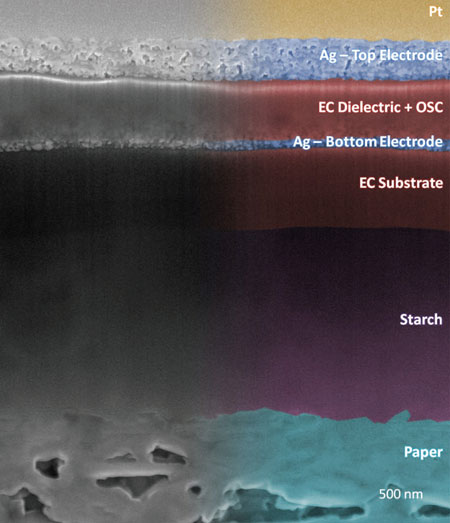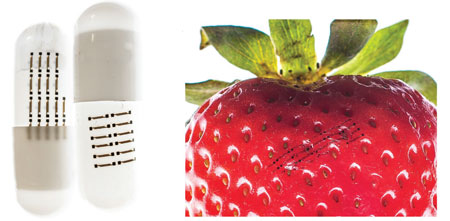| Apr 24, 2019 | |
Printed organic electronics you can eat(Nanowerk News) Researchers report that organic transistors composed mainly of ingestible materials, both p-type and n-type, can be easily transferred on edible substrates by means of untreated commercial tattoo-paper (Advanced Materials, "Tattoo-Paper Transfer as a Versatile Platform for All-Printed Organic Edible Electronics"). |
|
 |
|
| OFET structure and fabrication on tattoo-paper. Scanning electron microscopy (SEM) image of a cross-section, milled by focused ion beam (FIB), of the device on tattoo-paper: it is possible to distinguish the layers composing the substrate, EC, starch/dextrin and paper, as well as the sintered silver nanoparticles bottom and top contacts, and the dielectric EC layer. (Reprinted with permission by Wiley-VCH Verlag) | |
| This system constitutes a simple and versatile platform for the integration of fully printed organic circuitry on food and pharmaceutical drugs, and it relies on a transfer procedure that does not alter the integrity of the ingestible substrate. | |
| With the development of edible devices that can be safely ingested by patients, perform a test or release a drug, and then transmit a feedback, the pervasiveness of point-of-care testing can be further enhanced. | |
| The cost-effective and mass-scale production of this technology could favor its adoption also in underdeveloped countries, where many health issues are still endemic within the population, thanks to costs reduction. | |
| Furthermore, the food industry may find important applications of this technology too, in tracking, identification or monitoring of food specimens during preparation, delivery, and stocking. | |
 |
|
| Photograph of a set of silver electrodes transferred on to a pharmaceutical capsule (left) and on a strawberry. (Reprinted with permission by Wiley-VCH Verlag) | |
| By exploiting tattoo-paper (or decal transfer paper),the researchers showed that it is possible to easily and reliably transfer a sub-micron ethylcellulose (EC) layer onto many different items: the tattoo-paper is soaked with water that dissolves the starch sacrificial layer, and it is then pressed onto the target object; finally, the paper sheet is peeled off to release the conformable, hundreds of nanometers thick EC layer. | |
| EC is an ingestible material that can be commonly found in drug formulations as a coating agent, tablet binder or filler, while it is used as emulsifier in the food industry. | |
| In their work, the team fabricated different sets of p-type and n-type organic field-effect transistors (OFETs) onto temporary tattoo-paper, where EC acted both as transferrable substrate and as gate dielectric layer of the OFETs. | |
| They realized OFET electrodes by inkjet-printing and subsequent sintering of a commercially available silver nanoparticle ink. | |
| The team used four different polymer semiconductors in their tests to demonstrate the versatility of the transfer procedure and the compatibility with both good hole and electron transporting materials, as required by robust complementary logic circuits. | |
| The realization of these stable, low-voltage, low-cost, easily transferrable, biocompatible organic electronic devices will pave the way for the development of a new set of point-of-care testing systems, constituted by edible sensors able to effectively operate from within the GI tract. | |
| Ingestible electronic systems that can be degraded within the digestive tract are attractive with respect to passivated inorganic electronics, as they completely remove the possibility of accumulation in the human body, which may become an issue in case of severe pathologies. | |
| Inherent edibility may also enable the direct integration of electronic sensors into food in the form of embedded smart probes, following a perishable good along its entire lifespan and capable of alerting the consumer when alteration of the properties is taking place. | |
| Furthermore, being edibility an extreme case of ecocompatibility, the future development of such technology platform will at the same time favor the reduction of the environmental impact of large area and flexible electronics technologies at large. | |
| "Overall, with our work we take the first step along a promising path and demonstrate that printed polymer electronics is a potential enabler of such an appealing future technology," the authors conclude their report. |
 By
Michael
Berger
– Michael is author of three books by the Royal Society of Chemistry:
Nano-Society: Pushing the Boundaries of Technology,
Nanotechnology: The Future is Tiny, and
Nanoengineering: The Skills and Tools Making Technology Invisible
Copyright ©
Nanowerk LLC
By
Michael
Berger
– Michael is author of three books by the Royal Society of Chemistry:
Nano-Society: Pushing the Boundaries of Technology,
Nanotechnology: The Future is Tiny, and
Nanoengineering: The Skills and Tools Making Technology Invisible
Copyright ©
Nanowerk LLC
|
|
|
Subscribe to a free copy of one of our daily Nanowerk Newsletter Email Digests with a compilation of all of the day's news. |
